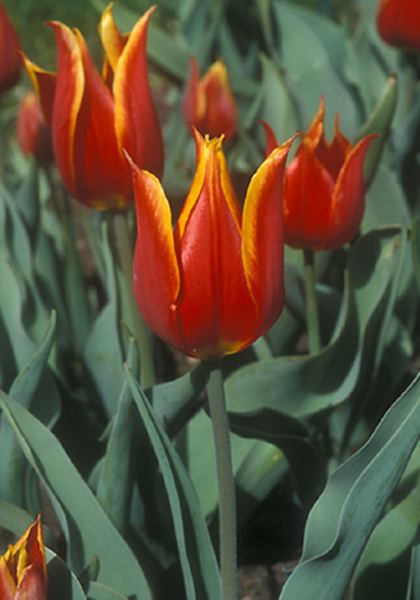Kingdom Plantae Family Liliaceae Scientific name Tulipa schrenkii Rank Species | Order Liliales Genus Tulipa Higher classification Tulip | |
 | ||
Similar Tulip, Tulipa biebersteiniana, Tulipa biflora, Tulipa gesneriana, Liliaceae | ||
Tulipa schrenkii or Schrenck's tulip is a bulbous herbaceous perennial of species of tulip (Tulipa) in the family of the Liliaceae. It belongs to the section tulipa.
Contents
Description
The tunic of the bulb is dark brown. Stiff hairs grow on the inside, especially towards the tip. The 3-4 leaves are glaucous and undulate. They are normally 10, sometimes up to 20 cm long and 3–6 cm wide. The stem is 15–30 cm long and glabrous, sometimes slightly hairy. The flowers of Tulipa schrenckii are bowl shaped and very varied in colour. They can be red, light-red, pink, yellow or white. There are also forms with red petals bordered in yellow or white
Habitat
Tulipa schrenckii grows in the Southern Ukraine, especially on the Crimea, the European part of Russia, especially on the lower Don and around the Sea of Azov, in Western Iran, Azerbaijan, Ciscaucasia (North-Ossetia, Kabardino-Balkaria and in the former Chechen–Ingush Autonomous Soviet Socialist Republic region on the Terek), northern Dagestan, western Kazakhstan, in Central Asia, China and the lowlands of western Siberia. The status of the Anatolian populations is dubious, as they could be descended from plants previously cultivated in gardens and parks. Gerhard Pils only lists Tulipa sylvestris, Tulipa humilis, Tulipa saxatilis and Tulipa armena as wild species. Christenhuit et al. assume "ca. seven" wild species, without listing them however. Tulipa schrenckii grows in the steppe and in semideserts, up to 600 m ASL. In Russia and Kazakhstan this tulip is listed on the Red List of endangered species.
Systematics
Tulipa schrenckii was first described in 1794 by Albrecht Wilhelm Roth in the "Annalen der Botanik" (ed. Usteri) 10, 44. as Tulipa suaveolens. The Latin ephithet suaveolens means sweet-smelling. Different species were described from different sites, which later turned out to be all members of the species Tulipa schrenckii. Tulipa schrenckii was described in 1873 by Eduard August von Regel in the Trudy Imperatorskago S.-Peterburgskago Botaničeskago Sada. The ephiteton schrenkii honours the Baltic-German botanist Alexander Gustav von Schrenk.
History
The wild Tulipa schrenckii is known in Turkey as Kefe Lale (also "Cafe-Lale" after the medieval name of Kaffa on the Crimea). Johannes Marius Cornelis Hoog thinks that it is one of the parent species of the horned tulip Tulipa cornuta, often wrongly labelled as Tulipa acuminata in the bulb-trade). Sultan Selim II had 300.000 bulbs brought from Kefe for the gardens of the Topkapı-Sarajı in Istanbul.
Tulipa schrenckii is also a progenitor of the low-growing Duc-tulips (also called Dukes, Dux or Ducks), which are attested in the Netherlands since the end of the 16th. century. They were named for Adrian Duyk from Oud-Karspel in the Netherlands.). A painting by Jakob de Gheyn II., originating between 1600 and 1603 depicts shells, a caterpillar and a vase with love-in the mist, a snake's head fritillary, roses, Aquilegia, lilies-of the valley, pansies and a Tulipa schrenckii with pointed petals. A moth is sitting on the vase. Drawings by Jakob de Gheyn show this plant as well Bulbs of Tulipa schrenkii were imported 1881 into the Netherlands, where they were hybridised with other domesticated tulips.
